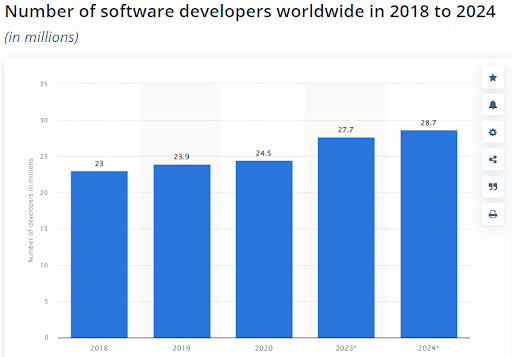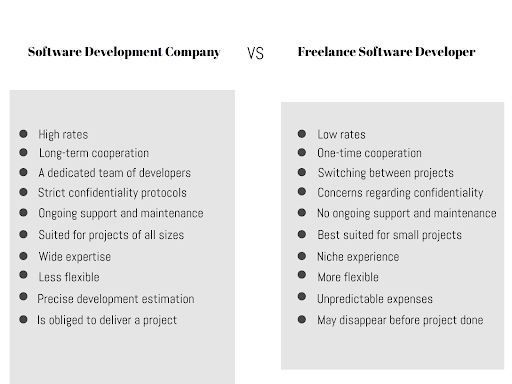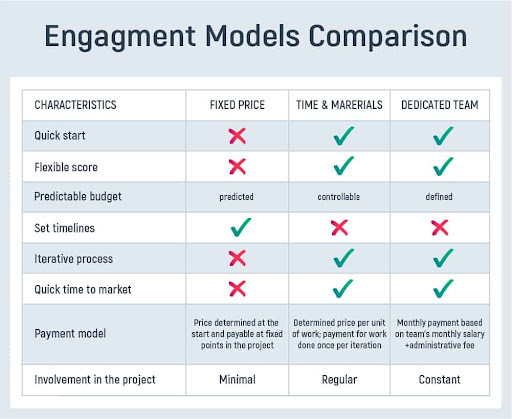How to Hire a Web Developer- A Step-by-Step Guide to Find the Best One

Have you decided to start a website but don’t know where to begin? Or perhaps you already have one, but it’s not meeting your business needs, so you’re looking for someone to revamp it? Our this blog is all about How to Hire a Web Developer and A step-by-step Guide to Find the Best One.
Either way, you need to hire a web developer. However, finding the right developer for your project can be challenging, especially if you’ve not hired one before or don’t know much about their job requirements and duties.
Here’s an interesting question for you. Do you know the number of software developers worldwide?
Well, the infographic below will offer a clear idea of the developer’s population worldwide:

Source: Statista- Developers Population
With 24.5 million software developers (in 2021) out there, it seems you have an infinite number of options to go for. Options help! Not really! Here these numbers seem a bane and not a boon.
However, the right strategy can easily land you the right developer for your project in no time. Before proceeding with anything else, analyze the end business goal you want to achieve via your software.
In other words, It’s essential to have some neat expectations before hiring someone for a job. Once you know the answers to:
- Business goals,
- Target audience,
- Technology stack, &
- Deployment platform of the software,
You can easily find the right candidate for the job.
Here’s How to Proceed for the Process of Finding/Hiring the Ideal Developer:
Step-1: Analyze the critical requirements of the project
Step-2: Choose a Compatible Technology Stack to Filter your Search
Step-3: Reaching Out to Outsourcing Firms v/s. Freelance Websites
Step-4: Checking Out the Developers Skills & Expertise
Step-5: Choosing an Engagement Model Based on the Project’s Needs
Step-6: Selecting a Convenient Payment Model
Step-1: Analyze the Critical Requirements of the Project

Like other business hiring decisions, it’s imperative to accurately analyze your project’s critical requirements before posting an ad. For example, if you need advanced functionality that isn’t yet supported by existing WordPress plug-ins, then you should hire someone who can build that functionality.
Do your research and determine what features and requirements are non-negotiable for your project to find the best answers for the following questions:
- Why are you building this software, website, mobile, or web app?
- Who is your target audience?
- What type of an impact would you want to achieve with your software, website, mobile or web app?
- Why will your software, website, mobile, or web app be successful?
- How can you prove that it’s something people need?
- How much can you afford to spend on development?
- How urgently do you need to complete it?
These are some of the things that help clarify your project requirements. The answers will dictate which type of developer you should hire and how to hire a web developer.
Step-2: Choose a Compatible Technology Stack to Filter your Search

Source: Statista- Top Frameworks
Free platforms are enough to get you started if your budget is limited. However, paid ones will be more suitable to get your development done if it’s significantly high. For example, when building a low-cost ecommerce platform, you can proceed with a WordPress developer. Similarly, using Magento as an open-source option would make sense if your budget is high.
Some of the top technology stacks for building web development projects include the following:
LAMP Stack:
It is an acronym that stands for Linux, Apache, MySQL, & PHP. Together, these open-source technologies have significantly impacted web development since their inception in the late 1990s. LAMP stacks are still considered one of today’s most popular technology stacks among developers and come with their own set of pros & cons.
MEAN Stack:
The MEAN stack is a free and open-source JavaScript web application framework that helps developers build dynamic websites and web applications using MongoDB, Express, AngularJS, and Node.js. The acronym stands for MongoDB, Express.js, AngularJS, and Node.js. Each part of the MEAN stack is an integral part of how it works together to create a powerful web app with dynamic data-driven from MongoDB.
MERN Stack:
The MERN Stack is a server-side web application stack composed of MongoDB, Express.js, React.js, and Node.js. The name stands for Mongo, Express, React, and Node—the components that make up the stack in their order of execution. It is designed to make building and deploying full-stack applications faster, easier, and more cost-effective than other stacks at that time.
MEVN Stack:
The MEVN stack is a web application development framework. The name comes from MongoDB, Express, Vue, and Node.js (MEVN). MEVN is an acronym for MongoDB + Express + Vue.js + NodeJS . These are server-side JavaScript runtimes commonly used in web application development to write all of their back-end functionality.
Serverless Stack:
Serverless refers to applications fully managed by a third-party provider rather than an individual server or virtual private server (VPS). Although many people hear serverless and think it means no servers, that isn’t strictly true. The most popular of these solutions is AWS Lambda, but similar offerings are from Google Cloud and Microsoft Azure.
Compare tech stacks to identify which one best suits your specific project’s requirements.
Step-3: Reaching Out to Outsourcing Firms v/s. Freelance Websites
You can either look for local freelancers through freelance websites or outsource your work overseas to lower rates by hiring outsourcing companies. However, each of these options comes with some caveats.
The infographic below offers insights into the significant differences between the two options:

Source- Zfort
If you decide to go through a freelance website, ensure that it has enough talent and potential customers before putting down money. Similarly, when you choose an offshoring company, analyze its rating over Clutch or other similar websites to get an idea about the company’s reputation.
Step-4: Checking Out the Developers Skills & Expertise

Creating an RFP for hiring a web developer will help you identify your needs and create a detailed list of qualifications that potential candidates must match. It also helps to ensure that you don’t have any hidden expectations, creating frustration and expense later.
While analyzing developers portfolio, look for the following aspects of their career:
- Years of experience as a coder or developer.
- What kind of experience do they hold? If they have worked in various domains, it is good to ask them questions about what they have done.
- Look for various projects they have done. More experience and several tasks will help you evaluate them as someone who can handle your project.
- Is there any distinctive feature of their work that shows their talent exclusively?
- Can they communicate technical skills practically (i.e., Demonstrating vs. writing)
Step-5: Choosing an Engagement Model Based on the Project’s Needs
Choosing an engagement model when working with a web developer depends on various factors. The most critical of which is: How much budget do you have? Some platforms charge fees for posting job descriptions, some for connecting with freelancers, and others commission freelancers on every project. In any case, if you’re working with a freelancer, you’ll have to invest in them initially.
The time taken in finding and vetting someone can be more expensive than connecting an outsourcing company. It would help if you consider the following things before selecting such an engagement model:
What type of project are you hiring them for?
Does it require frequent or repeated interaction?
Is communication with your team necessary during implementation?
Will your budget be able to sustain frequent changes in requirements or specifications?
Based on the answers to the above inquiries, you can proceed with any of the top 3 engagements models listed below:
The Project-Based Model:
You pay for all of your developers’ time, including communication with your team, and then make changes based on your feedback. This engagement model benefits large projects requiring frequent interaction between groups and smaller projects requiring regular updates and product changes by specifications. It’s also helpful if you have a small budget but require periodic revisions to what you want to be built.
Dedicated Team Business Model:
You pay for developers who work exclusively on your project, meaning they don’t work on any other projects during or after. This method is excellent if you want regular communication with your team and work exclusively on your project.
It’s not always beneficial for large projects that require constant interaction between teams, and it isn’t always cost-effective for more minor projects since it can get expensive.
Outstaff or Extended Team:
This method is best if you work with someone whose skill set aligns with what you need but don’t have time to work on your project exclusively. If you choose an out staff or extended team option, ensure that your developer regularly communicates with your team and updates you on their progress.
Their skills and expertise must also align with what’s necessary for your project. Choose enthusiastic people about working on something new or related to their current area of expertise.
Step-6: Selecting a Convenient Payment Model

Source- Inoxoft
There are three ways to pay your developers. Each has its pros and cons. Explore them:
Fixed Price:
If you have a particular software project in mind and know how much it will cost from start to finish, choosing the Fixed price would be ideal since you already know what amount of sum you want to spend on the project.
Dedicated/Hourly:
Choose the Hourly model when you know what your project will cost but lack knowledge on how long it will take to build. The advantages of the Hourly model are that you only pay for what you use, so if your project takes less time than expected, you’ll only pay for what has been used. On average, though, such projects take longer than initially planned and cost much more.
Time & Material:
The advantages of the time and material model are that it gives your developer more freedom in choosing how they will build your project. Simultaneously it lets you decide if a given feature is worth adding at all. So you’re only charged for what gets implemented. And the Time & Material Model is suitable when you don’t know what you want and have no clear idea of how much time it will take to complete.
Closing Thoughts
Businesses often outsource their development work to an offshore company or freelancer located overseas. While outsourcing your web design project can be an excellent solution for cash-strapped startups, other businesses may need to reduce costs by outsourcing abroad.
The main benefit of hiring from an offshore location is cost savings; developers and designers can charge significantly less than their counterparts in more expensive countries like Canada and Australia.
If you’re not looking for too much experience and want a quick turnaround on your project (e.g., less than five days), there are many talented developers overseas that you can hire relatively cheaply. Don’t think about that how to hire a web developer. Simply contact the PixelCrayons team and avail the best web development company services in India.
Read More in this Related Blog – https://www.dorjblog.com/latest-web-development-trends-to-follow-in-2022/





